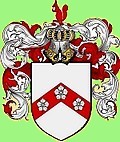 THE GILBERT FAMILY HISTORY
THE GILBERT FAMILY HISTORY
Tanners Manor (and Foxhunt Manor), East Sussex
Website created by Richard Gilbert, last updated 5 February 2021.
MAIN NAVIGATION MAP
GILBERT; Waldron 1700s & earlier
|
HASSELL; Waldron --
GILBERT; Waldron 1800s --
GILBERT; to the USA
|
SODDY; Sussex & London --
GILBERT; Eastbourne 1800s --
MORRIS; Lewes & Eastbourne
|
HEWITT & HEDGEGOTT --
GILBERT; Eastbourne 1900 onwards --
CLEMENTSON; London
|
GILBERT; in the USA
TANNERS MANOR - (occupied by the HASSELL family from 1876 to 1964)
============================================================
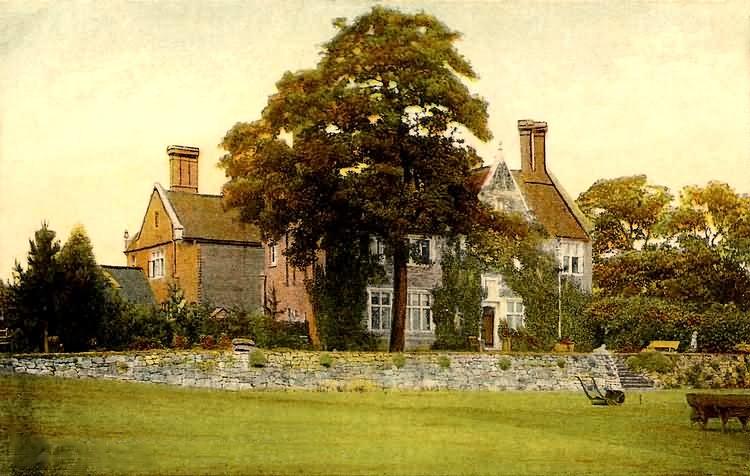
Tanners Manor around 1900, from a postcard (probably a hand-coloured photograph).
Tanners Manor, Lions Green, Waldron (sometimes called Great Tanners) is a Jacobean Manor House in parkland, first mentioned in historical records in 1570, in a survey of the rents paid by tenants for the then owner, Lord Buckhurst, later to be Sir Thomas Sackville, the 1st Earl of Dorset. The name of the property probably derived from the tanyard nearby, owned by the Mittel family, and which existed right up to Victorian times.
The Fuller family came to Sussex from London in the 1500s and Tanners Manor seems to have become one of their first homes. Fullers were soon widely spread around the county. This story involves a lot of Fullers, and a large number of them were named 'John Fuller' so, to help us to keep track, I've given numbers to five of them.
Our first John Fuller ('John Fuller 1') was born in 1506 (probably in London) but died in Waldron in 1574, so the family were certainly living in the area by that time. In fact his son John Fuller 2 was reportedly born in Tanners Manor around 1540, so that could be a more accurate marker of the family's arrival in the Manor. In 1575 John Fuller 2 took a 40-year lease on the property and began to acquire other land for farming in the area. 'John Fuller of Tanners' appears in the 1583 Waldron parish register.
However John was only a tenant, and the ownership of the estate passed (presumably from Lord Buckhurst) to Sir Philip Sidney, Elizabethan poet and courtier born at Penshurst Place. Sir Philip married Frances Walsingham, but he died in 1586 and she married again to Robert Devereux, 2nd Earl of Essex. Sir Philip's will showed that Tanners Manor was valued at £10 3s 0p and the property seems to have been inherited by their only child, daughter Elizabeth born in 1585. Named after the Queen, she married Roger Manners, 5th Earl of Rutland, in March 1599 (she was aged 14!).
Roger Manners was clearly a bad egg. He got involved with the Earl of Essex (see Frances Walsingham above), and was consequently implicated in the 1601 "Essex Rebellion". He was imprisoned at the Tower of London and fined an enormous £30,000. He had to sell a lot of family properties to pay the debt so it's no surprise that Tanners Manor was back in the hands of the Sackville family (Earls of Dorset) from 1603. It was tough for his wife Elizabeth too. They had no children, allegedly because the marriage was never consummated due to Rutland's syphilis. To make things worse, a goldsmith had Elizabeth arrested for debt in 1605.
Through all this, the Fullers had remained as tenants at Tanners Manor. But in 1617 Capt Samuel Fuller (son of John Fuller 2, and born in the Manor in 1589) appears to have bought the Manor from the Sackvilles. The exact date of the existing house is not known but, like many Elizabethan houses, its shape was designed to simulate the "E" monogram of the Queen. She died in 1603, so it must pre-date that. The initials "S.F." appear over the front door, which may well refer to Samuel Fuller's involvement with the project at some point. In 1653 Samuel died and ownership passed to his son John Fuller 3 (1617-1679).
It was around this time that the Fuller family became involved with the iron industry locally. They were owners of the Waldron Furnace and a 'hammer pond' which supplied water to the Furnace is still in existence near the Manor. This was used in conjunction with the iron workings at Heathfield, acquired in 1693. John Fuller 3 died in 1679 and ownership transferred to Major John Fuller 4 (1652-1722), and then to John Fuller 5 (1680-1745). Shortly after his marriage in 1703 John Fuller 5 moved to Brightling Park, which he had been given by his uncle, renaming it Rose Hill after his wealthy wife, Elizabeth Rose. This John was to become probably the most prosperous of the Sussex ironmasters, a real 'country gentleman', and grandfather to the famous 'Mad Jack' Fuller (1757-1834) of Brightling who doesn't get a number in this confusing tale, and whose life is a story in itself! The move to Brightling also started a decline in the connection between Tanners Manor and the Fuller family, which had lasted 200 years but was eventually to end in 1746.
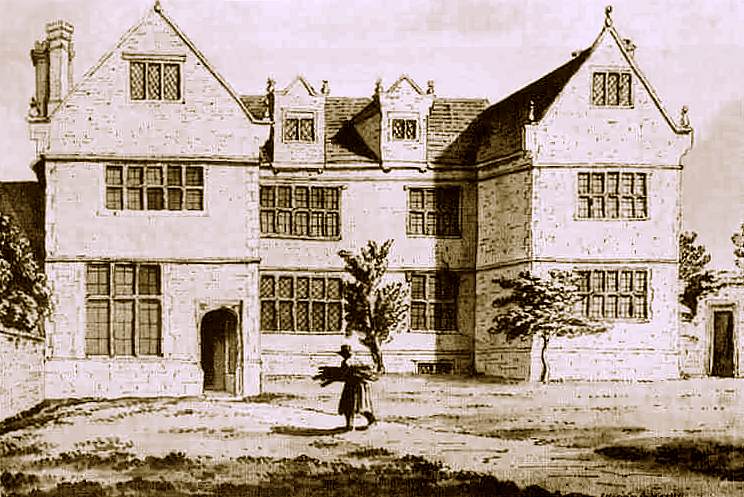
Tanners Manor in 1784. Pen and ink drawing by Samuel Hieronymus Grimm (1733-1794).
It's worth mentioning that yet another John Fuller (born in 1785, and who also doesn't get a number!) married Henrietta Hassell (born 1789) who was the sister of Thomas Hassell (1785-18??), father of Bendon Sharvell Hassell who bought Tanners Manor in 1876 - see below. So there was a direct link between the Fuller and Hassell families.
In 1746 the Manor of Tanners was described as consisting of "20 messuages, 1 mill, 1,000 acres of land, 150 of meadow, 150 of pasture, 200 of wood, 100 of marsh, common of pasture for all manner of cattle in the parishes of Waldron, Heathfield, Chiddingly, Pevensey, Hailsham, Hellingly, Berwick, Alciston, Selmeston, Willingdon and Brightling." In that year it was acquired by the Bonnick family, who are mentioned in Waldron parish records as far back as 1565. The family continued to own lands in the area (latterly at Foxhunt) until World War Two.
Around 1800, alterations were made to reduce the size of the building to that of a farmhouse and one wing of the Elizabethan "E" was removed. Farmer Josias Bonnick and his family were occupying "Great Tan House" at the 1841 and 1851 censuses, and William Kenward was the farmer at "Great Tanners" in 1867 and 1874.
A map of 1871 (apparently accompanying the house sale particulars, although it is not clear if the house was actually sold at that time) shows a crossroads at Tanners. The road running from Hanging Birch to Tanners continued straight across, just below the manor house, until it reached Dern Lane by the old blacksmiths forge at Lions Green. The Manor continued to be used (sometimes rented out) until 1876 when it was purchased and restored by Bendon Sharvell Hassell - see below.

THE HASSELL FAMILY AT TANNERS MANOR
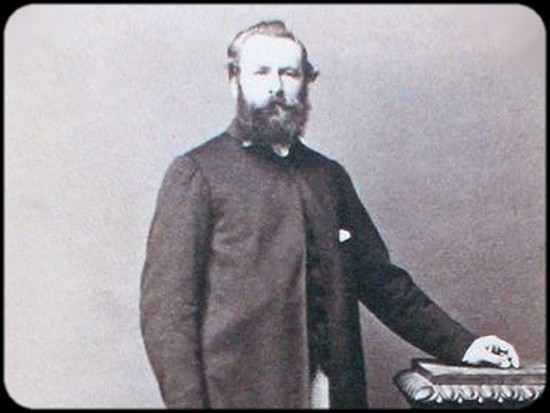
Bendon Sharvell Hassell
Bendon Sharvell Hassell (1829-1919) grew up in the family 'shop/house' in Waldron High Street and, from relatively humble beginnings, made himself very wealthy as a merchant in Australia between 1851 and 1865. Having returned to England he married Fanny Monckton (1830-1912) from Brenchley, Kent, in 1869 and bought Tanners Manor in 1876. They had two sons, Robert and Reginald.
 More details of Bendon and Fanny's family
More details of Bendon and Fanny's family
At the 1881 census the occupants of Tanners Farm (although the actual building is not known) were;
John Hemsley (aged 33) farmer, his wife Julia (30), 7 sons, 2 servants and 1 nurse.
Also somewhere on the estate were Thomas Booth (aged 26) farm labourer, his wife Flora (19), 1 son and 1 boarder / farm labourer.
and George Ades (aged 41) farm labourer, his wife Esther (38) and 7 children.
Benden's sons Robert de Bray Hassell (1870-1920) and Reginald Edward (1872-1953) were both later to become Eastbourne College boys. Robert was a Colonel, having fought in the South African war.
Both the 1909 and 1911 Kelly's Directories showed the occupants of Tanners Manor as being; "Hassell, Major Robert de Bray", "Hassell Benden Sharvell" and "Hassell Reginald Edward". Fanny died on 22 February 1912, and her husband Bendon was still alive at that time.
Under Bendon's instruction, alterations were made to the building. The staircase was built over the open fireplace, and the property thoroughly renovated. Much of the material from the old building was used to form the rock garden. Bendon died in 1919 and the property seems to have passed to his son Reginald Edward "Reggie" Hassell. A further wing was added to the house in 1926 (which is ironic considering that the house had been 'downsized' around 1800!). A temporary Army camp was set up at Tanners in the run-up to D-Day during the Second World War.
It was Reggie's death in 1953 that prompted the eventual sale of the property (after nearly ninety years in the family) on 12 June 1964 to Mr & Mrs J M Burns.
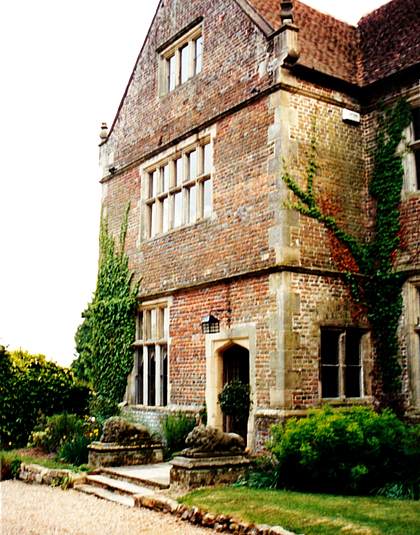
The main entrance to Tanners Manor in May 1995.
Photo by H R Gilbert during a visit by kind invitation of owners Charles & Joan Baker.
1984; Bought by Mr.& Mrs.J.Lucas.
1994; Bought by Charles and Joan Baker.
Later bought by Simon Fuller, artist manager and producer - yes, another Fuller!
References;
Richard Creasey's history of Waldron
Sussex Archaeological Collections Volume XIII.
Waldron; Portrait of a Sussex Village - Susan Russell et al.
Contributions from many family members.

FOXHUNT MANOR - FOXHUNT GREEN, WALDRON
==========================================
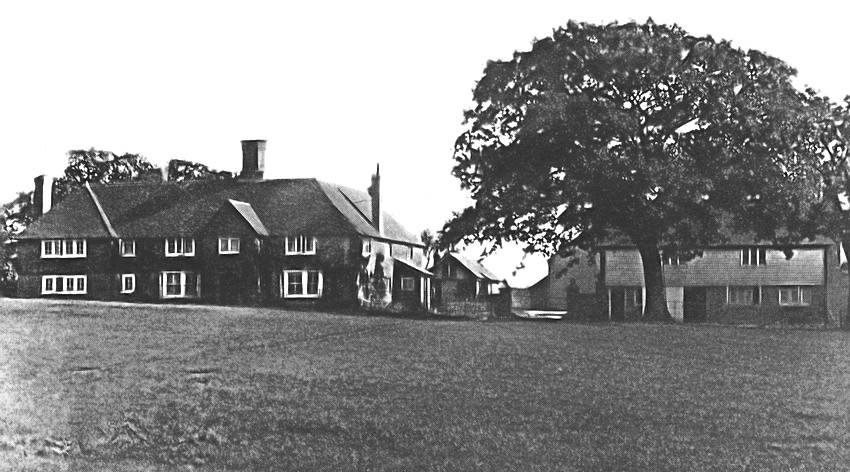
Foxhunt Old Manor House, from a postcard
There are two Foxhunt Manor houses at Foxhunt Green, near Waldron, East Sussex, both still standing;
(OLD) FOXHUNT MANOR; two-storey medieval manor house probably built in the 14th century.
(NEW) FOXHUNT MANOR; a larger red brick Victorian structure built in 1898.

NOTE!
There has long been a view within the family that the Hassells lived, at some stage, in Foxhunt Manor.
Delving through family records revealed that Ella Dowley, a grand-daughter of Ruth Anne Hassell (1815-1895), wrote to Charlotte Gilbert in March 1972; "..The Hassells lived at Foxhunt Manor, Waldron, and a son called Stephen Hassell was the first to be buried at Ocklynge." (Ocklynge Cemetery, Eastbourne)
After a lot of head-scratching and research by H R Gilbert in February 2021, this turns out to be the ONLY reference to the Hassell family living at Foxhunt. Tanners Manor yes, but Foxhunt Manor no. Maybe Ella made a mistake and got the wrong Manor. Also the two 'facts' in that sentence (the Hassells living at Foxhunt, and Stephen being buried at Ocklynge) are not necessarily related. Somehow we assumed that they were connected, i.e. that Stephen was born (or lived) at Foxhunt AND was buried at Ocklynge. That particular Stephen was born in 1820 and it was therefore inferred that he and all (or some of) his siblings were born (or lived) at Foxhunt - and therefore that his parents lived at Foxhunt at some time too.
This would date the possible Hassell occupation of Foxhunt Manor between around 1790 and 1820, but there is no evidence of that whatsoever. All records around that time show the family living in the "shop / house" at "Waldron Street", or at Hellingly, in the case of five of the children after 1812 who were apparently born there - including Stephen.
Stephen Hassell (1784-1857) married Susannah Bray of Waldron in May 1805. They had eight children during this period, who were;
George Hassell; (1807 - 18??) born in Waldron.
Thomas Hassell; (1808 - 1842) born in Waldron.
Harriett Hassell; (1812 - 1891) born in Hellingly.
Sophia Hassell; (1814 - 1882) born in Hellingly.
Ruth Ann Hassell; (1815 - 1895) born in Horsebridge, Hellingly.
Charlotte Hassell; (1817 - 1895) born in Hellingly.
Mary Hassell; (c1819 - 18??) born in Waldron.
Stephen Hassell; (1820 - 1881) born in Hellingly.
Therefore I believe that the Hassell family never did live at Foxhunt Manor. If the situation changes or new evidence turns up, you'll be the first to know.
